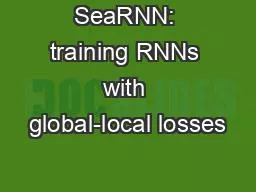/


Rémi Leblond JeanBaptiste Alayrac Anton Osokin Simon LacosteJulien INRIA Ecole Normale Supérieure MILADIRO UdeM ID: 814611
Download The PPT/PDF document "SeaRNN: training RNNs with global-local ..." is the property of its rightful owner. Permission is granted to download and print the materials on this web site for personal, non-commercial use only, and to display it on your personal computer provided you do not modify the materials and that you retain all copyright notices contained in the materials. By downloading content from our website, you accept the terms of this agreement.
Slide1
SeaRNN: training RNNs with global-local losses
Rémi Leblond*, Jean-Baptiste Alayrac*, Anton Osokin, Simon Lacoste-Julien INRIA / Ecole Normale Supérieure MILA/DIRO UdeM *equal contribution
Slide2Produce a sequence of hidden states by repeatedly applying a cell or unit on the input.
Can predict based on their previous outputs.RNNs: models for sequential data
From Goodfellow et al, 2016
Slide3Encoder-decoder architecture
The encoder RNN maps the input sequence into a compact representation that is fed to the decoder RNN. The decoder outputs a sequence by taking sequential decisions given the past information. State of the art for translation and other tasks.
[Sutskever et al, NIPS 2014
Cho et al, EMNLP 2014]
Encoder (RNN)
Input sequence
Output sequence
Decoder (RNN)
Slide4Probabilistic interpretation: Chain rule:
Training with MLE (teacher forcing): Known problems of MLE: * different from the test loss, * all-or-nothing loss (bad for structured losses), * exposure bias leading to compounding error.Existing approaches: Bahdanau et al (ICLR 2017), Ranzato et al (ICLR 2016), Bengio et al (NIPS 2015), Norouzi et al (NIPS 2016)
Standard training
Slide5Structured prediction
Goal: learn a prediction mapping f between inputs X and structured outputs Y, i.e. outputs that are made of interrelated parts often subject to constraints.Examples: OCR, translation, tagging, segmentation...Difficulty: there is an exponential number (with respect to the input size) of possible outputs (K^L possibilities if K is the alphabet size and L the number of letters). Standard approaches: SVM struct, CRFs...
X :
Y :
dlss
f
Slide6Learning to Search, a close relative? [SEARN, Daumé et al 2009]
Makes predictions one by one: each Yi is predicted sequentially, conditioned on X and the previous Yj (instead of predicting Y in one shot).Enables reduction: instead of learning a global classifier for Y, we learn a shared classifier for the Yi.Reduces SP down to a cost-sensitive classification problem, with theoretical guarantees on the solution quality.
Bonus: it addresses the problem mentioned before with MLE!
Slide7L2S, roll-in/roll-out
Trained with an iterative procedure: we create intermediate datasets for our shared cost sensitive classifier using roll-in/roll-out strategies.
Slide8Links to RNNs
Both rely on decomposing structured tasks into sequential predictions, conditioned on the past.Both use a unique shared classifier for every decision, using previous decisions.What ideas can we share between the two?While RNNs have built-in roll-ins, they don’t have roll-outs. Can we train RNNs using the iterative procedure
of learning to search?
From Goodfellow et al, 2016
Slide9Our approach: SeaRNN
Idea: use concepts from learning to search in order to train the decoder RNN.Integrate roll-outs in the decoder to compute the cost of every possible action at every step.Leverage these costs to enable better training losses.Algorithm:
Compute costs with roll-in/outs
Derive a loss from the costs
Use the loss to take a gradient step
Rinse and repeat
Slide10Roll-outs in RNNs
Slide11Roll-in: reference (teacher forcing)? learned? Roll-out:
reference? learned? mixed? We can leverage L2S theoretical results!Cost sensitive losses: since RNNs are tuned to be trained with MLE, can we find a structurally similar loss that leverages our cost information?Scaling: compared to MLE, our approach is very costly. Can we use subsampling to mitigate this? What sampling strategy should we use?The devil in the details
roll-out →
Reference
Mixed
Learned
↓ roll-in
Reference
MLE (with TL)
Inconsistent
Learned
Not locally opt.
Good
RL
From Chang et al, 2015
Slide12Expected benefits
Make direct use of the test error.Leverage structured information by comparing costs, contrary to MLE.Global-local losses, with global information at each local cell, whereas alternatives either use local information (MLE) or only work at the global level (RL approaches).Sampling: reduced computational costs while maintaining improvements.
Slide13Experimental results
SeaRNN (full algorithm) on OCR, text chunking and spelling correction:Sampling results:
Slide14Experimental takeaways
Significant improvements over MLE on all 3 tasks.The harder the task, the bigger the improvement.Learned/mixed is the best performing strategy for roll-in/out.The best performing losses are those structurally close to MLE.No need for warm start.
Sampling works, maintaining improvements at a fraction of the cost.
Slide15Future work
Large vocabulary problems (e.g. machine translation)Smarter sampling strategies hierarchical sampling curriculum sampling trainable sampling?Cheaper approximation of costs: actor-critic model?
Slide16Thank you! Questions?
Come to our poster to discuss!See our paper on arxiv: https://arxiv.org/abs/1706.04499